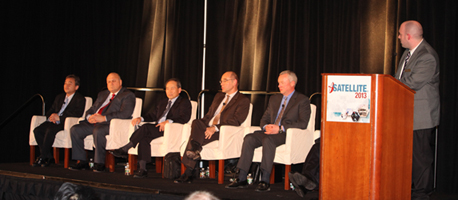
(Photo: courtesy Via Satellite and Kenny Bordelon)
During the Satellite 2013 conference in Washington, DC, thousands of industry executives from all over the world convened to discuss developments and dynamics and opportunities for growth and expansion. The launch services provider’s panel, Held on Tuesday, March 19, the “Launch Services: Expanding Global Options to Orbit” panel provided perspectives from a variety of launch service providers, including new entrants and veteran launchers. The panel focused on customer demand, adapting to new technologies and competing in an expanded launch marketplace. Speakers included Phil Slack, president of International Launch Services (ILS), as well as representatives from Sea Launch, Arianespace, SpaceX, Lockheed Martin Commercial Launch Services, and Mitsubishi Heavy Industries. The following is a summary of ILS’ participation in the panel discussion, moderated by Jeffrey Hill, Editor of Via Satellite.
An Active Year Ahead for ILS and Proton
This April will mark the 20th anniversary of the formation of the commercial Proton business. Khrunichev State Research and Production Space Center (Khrunichev), ILS majority owner, and a leader in the Russian space industry, manufactures the Proton vehicle – the heavy-lift heritage vehicle, which is entering its 49th year of service and has performed 383 launches to date, including 77 with ILS.
ILS is preparing for a very active year starting with the return-to-flight launch on March 27th, with the Satmex 8 satellite onboard. ILS will continue launching one commercial mission per month through August, with an additional one to two commercial missions in the fourth quarter. There are also three to five federal Proton launches planned in 2013.
Over the last six years, Proton has launched an average of ten times per year – the highest launch rate among all heavy-lift launchers. ILS has been loyally supporting the industry and its customers for decades and looks forward to many more years of future service.
A Unique Perspective on the Industry
Along with the other panelists, Slack offered his perspective on what it is like to work in the launch business having spent 26 years in the industry – half of that with Boeing working on the Delta/Titan programs and the other half with ILS and Proton.
According to Slack, with the launch industry, you have the opportunity to experience a program from early negotiations to contract, to the final performance with the launch. And the launch itself is a spectacular experience–with the powerful sound and sight of the Proton lift off and early flight. The ultimate level of gratification is to see a satisfied customer after all of the hard work leading up to mission success, and he looks forward to experiencing this once again with Satmex, viewing the Satmex 8 launch next week.
New Developments and Launch Offerings
In response to the question on the next generation vehicle, Slack stated that while the Proton vehicle continues to be the product offering for the near term, the Angara family of vehicles with a light, medium and heavy-lift variant, are on a steady development track with the first flight of the Angara 1.2 vehicle scheduled for this year from the Plesetsk launch base. The upcoming first flight will support a Federal mission and after successful introduction of the vehicle, it will be offered commercially. However, the commercial launch pad for the Angara still needs to be funded and built.
Accommodating Changes in Spacecraft Design and New Technologies
As spacecraft are becoming larger, more complex and business plans are becoming more refined, ILS and Khrunichev are adapting with new capabilities. ILS and Khrunichev are continually working on new developments to accommodate the evolving needs of its customers in terms of mass, volume, cost and schedule assurance. In terms of heavy-lift, when the Proton was first introduced to the commercial market, the lift capability was around 5 metric tons to GTO. Over the years, Khrunichev and ILS have increased that capability to 6.15 metric tons to GTO, and enhancements to the vehicle are ongoing. In 2011, the increased lift performance was demonstrated with the launch of ViaSat-1; the high-powered, Ka-band satellite weighed nearly 6.8 metric tons at liftoff. More frequent use of hosted or shared payloads has also led to more business cases for larger satellites.
In addition to spacecraft mass growth there are also increases in spacecraft size for design flexibility. ILS and Khrunichev are addressing this need by developing a 5.1 meter diameter payload fairing for the Proton with extra spacecraft volume for larger configuration antennas and reflectors. Launches that feature this larger payload fairing are scheduled to begin in 2016.
Moreover, the use of electric propulsion to reduce propellant mass needed to get to geostationary orbit and thereby maximizing the usable mass to orbit is an exciting development for the commercial satellite industry. Owners of these spacecraft as well as others are seeking an economical way to launch smaller to medium size satellites to orbit in a shared or dual launch capacity. Slack ensured that ILS has addressed the need for a cost effective option for launching small to medium sized satellites to orbit. The current Proton vehicle is capable of launching two spacecraft at once; this was first commercially demonstrated with the SES-3/Kazsat-2 mission in July 2011 and was previously flight-proven with numerous Russian Federal missions. ILS is working with all of the satellite manufacturers to ensure compatibility with the Proton for such configurations.
The Supply and Demand Equation
Slack addressed the question on current supply and demand, by explaining the dynamics that new entrants and veteran launchers have within the existing market. With relatively flat demand and oversupply of launch services, there would be a developing rationalization of the market. , with weaker players exiting or serving the more profitable government sector, which is what occurred in the 1990s with the Atlas and Delta vehicles. The most sustainable business model for any commercial launch provider, Slack concluded, is one with a strong federal program as a supporting foundation.
